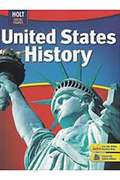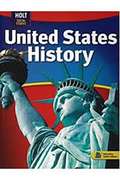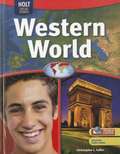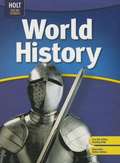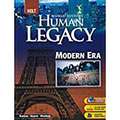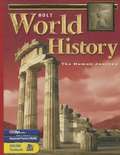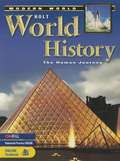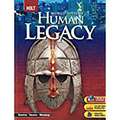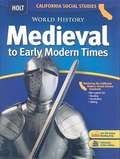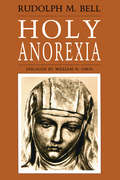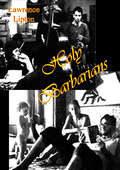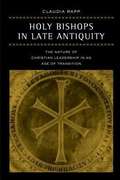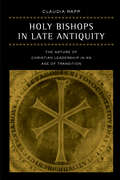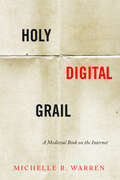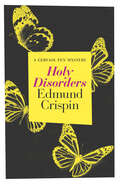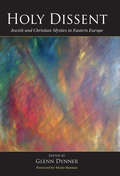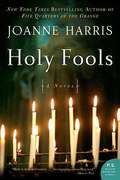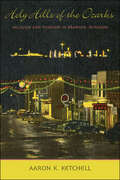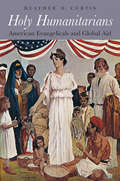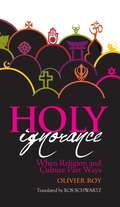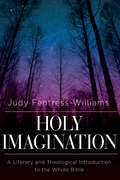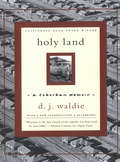- Table View
- List View
Holt Social Studies: World History, Ancient Civilizations Interactive Reader and Study Guide
by Holt Rinehart WinstonHistory is the study of the past. Historians are people who study history. Historians want to know how people lived and why they did the things they did. They try to learn about the problems people faced and how they found solutions. They are interested in how people lived their daily lives. They study the past to understand people's culture.
Holt United States History
by William Deverell Deborah Gray WhiteStudents will learn history from different types of sources, mainly primary and secondary sources.
Holt United States History and New York State History
by William Deverell Deborah Gray WhiteThe 2009 Student Edition of the popular US History text.
Holt Western World
by Christopher L. SalterThis book is all about geography and history of the Western world along with test taking strategies.
Holt World History
by Richard Shek Stanley BursteinThis textbook uses both primary and secondary sources to make students better historians.
Holt World History, Human Legacy: Modern Era
by Susan Elizabeth Ramirez Peter Stearns Sam Wineburg Steven A. GoldbergNIMAC-sourced textbook
Holt World History, The Human Journey
by Holt Rinehart WinstonAll you need to do is watch of read the news to see history unfolding. How many news stories do you see or hear about ordinary people doing extraordinary things? The Why It Matters Today feature beginning every section of the Human Journey invites you to use the vast resources of CNNfyi.com or other current event source to examine the links between past and present. Through this feature you will be able to draw connections between what you are studying in your history book and the events are taking place in out world today.
Holt World History, the Human Journey: Ancient World
by Holt Rinehart WinstonHolt World History shows the relation between geography and history.
Holt World History, the Human Journey: Modern World
by Holt Rinehart WinstonHistory and geography share many elements. History describes important events that have taken place from ancient times until the present day. Geography describes how physical environments affect human events. It also examines how people's actions influence the environment around them. One way to look at geography is to identify essential elements of its study.
Holt World History, the Human Journey: Modern World
by Holt Rinehart WinstonThroughout The Human Journey, you are asked to think critically about the events and issues that have shaped world history. Critical thinking is the reasoned judgment of information and ideas. The development of critical thinking skills is essential to effective citizenship. Such skills empower you to exercise your civic rights and responsibilities. Helping you develop critical thinking skills is an important goal of The Human Journey. The following critical thinking skills appear in the section reviews and chapter reviews of the book.
Holt World History: Human Legacy (Grades 9-12)
by Susan Elizabeth Ramirez Peter Stearns Sam Wineburg Steven A. GoldbergHolt World History: Human Legacy was created to make the study of world history an enjoyable, meaningful experience.
Holt World History: Medieval to Early Modern Times (Calfornia Social Studies)
by Richard Shek Stanley M. BursteinHistory textbook for California students.
Holy Anorexia
by Rudolph M. Bell&“A brilliant, disturbing study of anorexic behavior amongst medieval Italian female saints . . . original, controversial, superbly executed.&” —Kirkus Reviews Is there a resemblance between the contemporary anorexic teenager counting every calorie in her single-minded pursuit of thinness, and an ascetic medieval saint examining her every desire? Rudolph M. Bell suggests that the answer is yes. &“Everyone interested in anorexia nervosa . . . should skim this book or study it. It will make you realize how dependent upon culture the definition of disease is. I will never look at an anorexic patient in the same way again.&” —Howard Spiro, M.D., Gastroenterology &“[This] book is a first-class social history and is well-documented both in its historical and scientific portions.&” —Vern L. Bullough, American Historical Review &“A significant contribution to revisionist history, which re-examines events in light of feminist thought . . . Bell is particularly skillful in describing behavior within its time and culture, which would be bizarre by today&’s norms, without reducing it to the pathological.&” —Mary Lassance Parthun, Toronto Globe and Mail &“Bell is both enlightened and convincing. His book is impressively researched, easy to read, and utterly fascinating.&” —Sheila MacLeod, New Statesman
Holy Barbarians
by Lawrence LiptonMr. Lipton's book is the first complete and unbiased survey of the beat generation and its role in our society. Here are the intimate facts about these people and their attitudes toward sex, dope, jazz, art, religion, parents, landlords, employers, politicians, draft boards, the law and, most important, toward the "square". The author presents a picture of their way of life, their individual backgrounds, the language they have appropriated, in terms made clear for the first time to those of us who have been confused and puzzled about them. He also provides a balanced discussion of their literature, art and music, of what they produce and fail to produce in the arts they practice.--Print Ed.
Holy Bishops in Late Antiquity: The Nature of Christian Leadership in an Age of Transition
by Claudia RappThis book offers a new interpretation of the nature of bishops' power in late antiquity, arguing that bishops had a pragmatic approach to power much like that of secular rulers.
Holy Bishops in Late Antiquity: The Nature of Christian Leadership in an Age of Transition (Transformation of the Classical Heritage #37)
by Claudia RappBetween 300 and 600, Christianity experienced a momentous change from persecuted cult to state religion. One of the consequences of this shift was the evolution of the role of the bishop--as the highest Church official in his city--from model Christian to model citizen. Claudia Rapp's exceptionally learned, innovative, and groundbreaking work traces this transition with a twofold aim: to deemphasize the reign of the emperor Constantine, which has traditionally been regarded as a watershed in the development of the Church as an institution, and to bring to the fore the continued importance of the religious underpinnings of the bishop's role as civic leader. Rapp rejects Max Weber's categories of "charismatic" versus "institutional" authority that have traditionally been used to distinguish the nature of episcopal authority from that of the ascetic and holy man. Instead she proposes a model of spiritual authority, ascetic authority and pragmatic authority, in which a bishop's visible asceticism is taken as evidence of his spiritual powers and at the same time provides the justification for his public role. In clear and graceful prose, Rapp provides a wholly fresh analysis of the changing dynamics of social mobility as played out in episcopal appointments.
Holy Digital Grail: A Medieval Book on the Internet (Stanford Text Technologies)
by Michelle R. WarrenMedieval books that survive today have been through a lot: singed by fire, mottled by mold, eaten by insects, annotated by readers, cut into fragments, or damaged through well-intentioned preservation efforts. In this book, Michelle Warren tells the story of one such manuscript—an Arthurian romance with textual origins in twelfth-century England now diffused across the twenty-first century internet. This trajectory has been propelled by a succession of technologies—from paper manufacture to printing to computers. Together, they have made literary history itself a cultural technology indebted to colonial capitalism. Bringing to bear media theory, medieval literary studies, and book history, Warren shows how digital infrastructures change texts and books, even very old ones. In the process, she uncovers a practice of "tech medievalism" that weaves through the history of computing since the mid-twentieth century; metaphors indebted to King Arthur and the Holy Grail are integral to some of the technologies that now sustain medieval books on the internet. This infrastructural approach to book history illuminates how the meaning of literature is made by many people besides canonical authors: translators, scribes, patrons, readers, collectors, librarians, cataloguers, editors, photographers, software programmers, and many more. Situated at the intersections of the digital humanities, library sciences, literary history, and book history, Holy Digital Grail offers new ways to conceptualize authorship, canon formation, and the definition of a "book."
Holy Disorders (The Gervase Fen Mysteries)
by Edmund CrispinThis 1945 classic British mystery from &“a master of the whodunnit . . . combines a flawless plot, witty dialogue and a touch of surreal hilarity&” (The New York Times Book Review). On holiday in the town of Tolnbridge with his butterfly net in hand, Prof. Gervase Fen, Oxford don of English Literature, is all set for a good frolic when he learns that the cathedral organist has been murdered. With Scotland Yard unable to make sense of the crime, Fen stands ready to step in. Whether he&’s chasing butterflies or catching criminals, it&’s all the same to this amateur sleuth with a penchant for literary allusions and an uncanny knack for solving the unsolvable: like why a small-town church musician would be mixed up with a local coven of witches—or a spy ring of Nazi sympathizers? Finding the answers provides endless amusement for Fen—and for readers as well—in this golden age English detective novel from Edmund Crispin, &“an absolute must for devotees of cultivated crime fiction.&” —Kirkus Reviews Praise for the mysteries of Edmund Crispin &“A marvellous comic sense.&” —P. D. James, New York Times–bestselling author of the Inspector Adam Dalgliesh series &“Master of fast-paced, tongue-in-cheek mystery novels, a blend of John Dickson Carr, Michael Innes, M.R. James, and the Marx Brothers.&” —Anthony Boucher, author of the Fergus O&’Breen series &“One of the most literate mystery writers of the twentieth century.&” —The Boston Globe &“Beneath a formidable exterior he had unsuspected depths of frivolity.&” —Philip Larkin, author of A Girl in Winter &“One of the last exponents of the classical English detective story.&” —The Times (London)
Holy Dissent: Jewish and Christian Mystics in Eastern Europe
by Glenn Dynner Moshe RosmanBrings together highly regarded scholars of Jewish and Christian mysticism in Eastern Europe to analyze the overlap of mysticism in the two religions.
Holy Fools
by Joanne HarrisJoanne Harris, bestselling author of Chocolat, presents her most accomplished novel yet -- an intoxicating concoction that blends theology and reason, deception and masquerade, with a dash of whimsical humor and a soupçon of sensuality. Britanny, 1610. Juliette, a one-time actress and rope dancer, is forced to seek refuge among the sisters of the abbey of Sainte Marie-de-la-mer. Reinventing herself as Soeur Auguste, Juliette makes a new life for herself and her young daughter, Fleur. But when the kindly abbess dies, Juliette's comfortable existence begins to unravel. The abbey's new leader is the daughter of a corrupt noble family, and she arrives with a ghost from Juliette's past -- Guy LeMerle, a man she has every reason to fear and hate. This P.S. edition features an extra 16 pages of insights into the book, including author interviews, recommended reading, and more.
Holy Hills of the Ozarks: Religion and Tourism in Branson, Missouri (Lived Religions)
by Aaron K. Ketchell“Confronts readers with the implications of a popular tourist destination founded on the values and sentiments of American evangelical Protestantism.” —Thomas S. Bremer, Journal of the American Academy of ReligionOver the past century, Branson, Missouri, has attracted tens of millions of tourists. Nestled in the heart of the Ozark Mountains, it offers a rare and refreshing combination of natural beauty and family-friendly recreation—from scenic lakes and rolling hills to theme parks and variety shows. It has boasted of big-name celebrities, like Wayne Newton, Andy Williams, and Petula Clark, as well as family entertainers like Mickey Gilley, the Shanghai Magic Troupe, Jim Stafford, and Yakov Smirnoff.But there is more to Branson’s fame than just recreation. As Aaron K. Ketchell discovers, a popular variant of Christianity underscores all Branson’s tourist attractions and fortifies every consumer success. In this lively and engaging study, Ketchell explores Branson’s unique blend of religion and recreation. He explains how the city became a mecca of conservative Christianity—a place for a “spiritual vacation”—and how, through conscious effort, its residents and businesses continuously reinforce its inextricable connection with the divine.Ketchell combines the study of lived religion, popular culture, evangelicalism, and contemporary American history to present an accurate and honest account of a distinctly American phenomenon.“As Ketchell brilliantly argues, Branson entrepreneurs wove Christian sentiment ‘into a fabric of nostalgia, premodern longing, and whitewashed rusticity.’” —Matthew Avery Sutton, The Christian Century“At a time when Jim Wallis and other observers have forecast the end of the prominence of right-wing-religion on the U.S. political stage, this book will cause many readers to question that prediction.” —David Stricklin, The Journal of Southern History
Holy Humanitarians: American Evangelicals and Global Aid
by Heather D. CurtisOn May 10, 1900, an enthusiastic Brooklyn crowd bid farewell to the Quito. The ship sailed for famine-stricken Bombay, carrying both tangible relief—thousands of tons of corn and seeds—and “a tender message of love and sympathy from God’s children on this side of the globe to those on the other.” The Quito may never have gotten under way without support from the era’s most influential religious newspaper, the Christian Herald, which urged its American readers to alleviate poverty and suffering abroad and at home. In Holy Humanitarians, Heather D. Curtis argues that evangelical media campaigns transformed how Americans responded to domestic crises and foreign disasters during a pivotal period for the nation. Through graphic reporting and the emerging medium of photography, evangelical publishers fostered a tremendously popular movement of faith-based aid that rivaled the achievements of competing agencies like the American Red Cross. By maintaining that the United States was divinely ordained to help the world’s oppressed and needy, the Christian Herald linked humanitarian assistance with American nationalism at a time when the country was stepping onto the global stage. Social reform, missionary activity, disaster relief, and economic and military expansion could all be understood as integral features of Christian charity. Drawing on rigorous archival research, Curtis lays bare the theological motivations, social forces, cultural assumptions, business calculations, and political dynamics that shaped America’s ambivalent embrace of evangelical philanthropy. In the process she uncovers the seeds of today’s heated debates over the politics of poverty relief and international aid.
Holy Ignorance: When Religion and Culture Part Ways (Columbia/Hurst)
by Olivier RoyOlivier Roy, world renowned authority on Islam and politics, finds in the modern disconnection between faith communities and sociocultural identities a fertile space for fundamentalism to grow. Instead of freeing the world from religion, secularization has encouraged a kind of holy ignorance to take root, an anti-intellectualism that promises immediate, emotional access to the sacred and positions itself in direct opposition to contemporary pagan culture. The secularization of society was supposed to free people from religion, yet individuals are converting en masse to fundamentalist faiths, such as Protestant evangelicalism, Islamic Salafism, and Haredi Judaism. These religions either reconnect adherents to their culture through casual referents, like halal fast food, or "deculturate" through "purification" rituals, such as speaking in tongues, a practice that allows believers to utter a language entirely their own. Instead of a return to traditional religious worship, we are now witnessing the individualization of faith and the disassociation of faith communities from ethnic and national identities. This has placed culturally integrated religions, such as Catholicism and eastern orthodox Christianity, on the defensive, and presents new challenges to state and society. Roy explores the options available to powers that hope to integrate or control these groups and whether marginalization or homogenization will further divide believers from their culture.
Holy Imagination: A Literary and Theological Introduction to the Whole Bible
by Judy Fentress-WilliamsThe many voices in scripture form a dialogue with readers, which produce theological truths that are larger than the individual parts. This introduction is informed by both literary theory and theology. It groups sections of the whole Bible together by genre. Each section identifies and describes the genre (such as historiography, poetry, prophecy, gospel, letter, apocalypse), and then moves into a discussion about the literary characteristics and theological insights.The words of scripture not only come a long way to find us but like a poem must be read with attention. Poetry doesn’t yield meaning easily, and it doesn’t promise to make sense. We know to look past the words on the page and find the images, tropes, sounds, and metaphors that are meaning-full. This type of writing invites, rather demands, the imagination. We must accept that we will only get so close, but that this is close enough. Our imagination spans the gaps left by sparse language and incomplete narratives. We return again and again, with more information and perhaps more experiences. The words are the same, but we are not; and for that reason there are always new discoveries.“At last, an introduction that students will enjoy reading, because it is at once engaging, informative, and eye-opening, as well as completely lucid. Fentress Williams shows how many books of the Bible reflect the experience of marginalized persons and communities in precarious situations, and therefore how they speak in ways both realistic and encouraging to contemporary readers. Do your students and yourself a favor: adopt this text and get ready for serious conversation about ancient texts that never go out of date.”– Ellen F. Davis, Amos Ragan Kearns Distinguished Professor of Bible and Practical Theology, Duke Divinity School
Holy Land: A Suburban Memoir
by D. J. Waldie"Infinitely moving and powerful, just dead-on right, and absolutely original."--Joan Didion Since its publication in 1996, Holy Land has become an American classic. In "quick, translucent prose" (Michiko Kakutani, New York Times) that is at once lyrical and unsentimental, D. J. Waldie recounts growing up in Lakewood, California, a prototypical post-World War II suburb. Laid out in 316 sections as carefully measured as a grid of tract houses, Holy Land is by turns touching, eerie, funny, and encyclopedic in its handling of what was gained and lost when thousands of blue-collar families were thrown together in the suburbs of the 1950s. An intensely realized and wholly original memoir about the way in which a place can shape a life, Holy Land; is ultimately about the resonance of choices--how wide a street should be, what to name a park--and the hopes that are realized in the habits of everyday life. 20 illustrations and a new introduction for this paperback edition.

